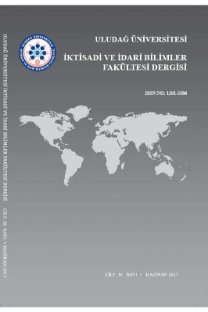The role of news approach in explaining exchange rate volatility
Bretton Woods sistemine son verildikten sonra geliştirilen esnek fiyat para modeli, yapışkan fiyat para modeli ve portföy denge modeli gibi modeller döviz kurlarındaki dalgalanmaları açıklamakta kısmen başarılı olmuşlardır. Dolayısıyla, bu alanda yapılan çalışmalar ekonomiyle ilgili açıklamaların döviz kurları üzerindeki etkisini tespit etmeye yoğunlaşmıştır. Bu makalenin amacı, para modeli ile ilgili yapılan ampirik çalışmaların ekonomiyle ilgili açıklamaların ya da beklenmeyen olayların döviz kurlarındaki dalgalanmaları açıklamakta başarılı olup olmadıklarını belirlemektir.
Since the breakdown of the Bretton Woods system, existing structural models of exchange rate determination such as flexible-price monetary model, sticky-price monetary model, and portfolio balance model have been partly successful in explaining exchange rate volatility. Therefore, the focus of this line of study has shifted to capture the role of economic news on exchange rates. The purpose of this paper is to review the literature related to the role of news or unexpected events within the framework of the monetary approach to exchange rate determination and to indicate whether the news framework has been successful in explaining volatility in exchange rates.
___
Almeida, A., Goodhart, C., and Payne, Richard, (1998), "The Effects of Macroeconomic News on High Frequency Exchange Rate Behavior", Journal of Financial and Quantitative Analysis, 33, pp.383-408.Bilson, F.D.J., (1978), "Rational Expectations and the Exchange Rate," in J.A. Frenkel and H.G. Johnson (eds.), The Economics of Exchange Rates: Selected Studies, New York: Addision-Wesley Publishing Company.
Chiang, T.C., (1988), "The Forward Rate as a Predictor of the Future Spot Rate- A Stochastic Coefficient Approach," Journal of Money, Credit and Banking, 20, pp.212-232.
Dornbusch, R., (1976), "Expectations and Exchange Rate Dynamics," Journal of Political Economy, 6, pp.1161-1176.
Dornbusch, R.,(1980), "Exchange Rate Economics: Where Do We Stand?" Brookings Papers on Economic Activity, 10, pp.143-185.
Dominguez, M.K., (1999), "The Market Microstructure of Central Bank Intervention," NBER Working Paper Series 7337.
Edwards, S., (1983), "Floating Exchange Rates, Expectations and New Information," Journal of Monetary Economics, 11, pp. 321-336.
Engles, F.R., Ito, T. and Lin, W., (1990), "Meteor shows and Heat Waves? Heteroskedastic Intra-Daily Volatility in the Foreign Exchange Market," Econometrica, 58, pp.525-542.
Ewans, M.D.D., and Lyons, R.K., (2003), "How is Macro News Transmitted to Exchange Rates?", NBER Working Paper No.9433
Frankel, A.J., (1979), "On the Mark: A Theory of Floating Exchange Rates on Real Interest Differentials", The American Economic Review, 4, pp.610-622.
Frenkel,A.J., (1978),"A Monetary Approach to the Exchange Rate: Doctrinal Aspects and Empirical Evidence," in J.A. Frenkel and H.G. Johnson (eds.), The Economics of Exchange Rates: Selected Studies, California: Addision-Wesley Publishing Company.
Frenkel,A.J., and Mussa, M.L., (1980), "The Efficiency of Foreign Exchange Markets and Measures of Turbulence," American Economic Review, 70, pp.374-381.
Frenkel,A.J., (1981), "Flexible Exchange Rates, Prices and the Role of News: Lessons from the 1970s," Journal of Political Economy, 4, pp.665-701
Frenkel,A.J., and Mussa, M.L., (1985), "Asset Markets, Exchange Rates, and the Balance of Payments," in R.W.Jones and P.B. Kenen (eds.), Handbook of International Economics, vol. II, New York: Elseiver Science Publishers B.V.
Hoffman, L.D. and Schlagenhauf, D.E., (1985), "The Impact of News and Alternative Theories of Exchange Rate Determination," Journal of Money, Credit and Banking, 17, pp.328-346.
Hordouvelis, A.G., (1988), "Economic News, Exchange Rates and Interest Rates," Journal of International Money and Finance, 7, pp.23-35.
Isard, P. (1983), "An Accounting Framework and Some Issues for Modeling How Exchange Rates Respond to the News," in J.A. Frenkel (eds.), Exchange Rates and International Macroeconomics, Chicago: The Uni. Chicago Press.
Kelin, M., Mizrach, B., and Murphy, R.G., (1991), "Managing the Dollar: Has the Plaza Agreement Mattered?" Journal of Money, Credit, and Banking, 4, pp.742-751.
Levich, M.R., (1985), "Empirical Studies of Exchange Rates: Price Behavior, Rate Determination and Market Efficiency," in R.W. Jones and P.B. Kenen (eds.), Handbook of International Economics, vol. II, New York: Elseiver Science Publishers B.V.
Mussa, M., (1978), "The Exchange Rate, the Balance of Payments, and Monetary and Fiscal Policy Under a Regime of Controlled Floating," in J.A. Frenkel and H.G. Johnson (eds.), The Economics of Exchange Rates: Selected Studies, California: Addision-Wesley Publishing Company.
- ISSN: 1301-3386
- Yayın Aralığı: Yılda 2 Sayı
- Başlangıç: 2018
Sayıdaki Diğer Makaleler
Takım yönetimi ve etkin takım yönetimine bir örnek: Chevron'da kendini yöneten takım uygulaması
Bilgi teknolojisi yatırımlarının yönetimi ve üst yönetimin süreçteki rolü: Bir örnek olay çalışması
Gürsan ÇOBAN, Hamit Aykut TURAN
Azınlıklar sorunu: Uluslararası hukuk ve Türk hukuku açısından bir analiz
The role of news approach in explaining exchange rate volatility
Veri madenciliğinde kullanılacak verilerin standartlaştırılması ve iyileştirilmesi
Abdulkadir Özdemir, Y. Ziya AYIK, Uğur YAVUZ
Banka ödünçleri kanalı: Literatür ve Türkiye örneği (1986-2000)
Üretim sistemlerinde negatif sapmalı hedef programlama uygulaması
